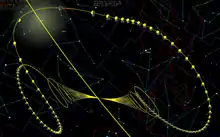Comet West
Comet West, formally designated C/1975 V1, 1976 VI, and 1975n, was a comet described as one of the brightest objects to pass through the inner Solar System in 1976. It is often described as a "great comet."[4]
 Comet West on March 9, 1976 | |
| Discovery | |
|---|---|
| Discovered by | Richard M. West |
| Discovery date | August 10, 1975 |
| Alternative designations | C/1975 V1, 1976 VI, 1975n |
| Orbital characteristics A | |
| Epoch | 1976-Mar-03 (JD 2442840.5)[1] |
| Aphelion | up to 70,000 AU[2] (1.1 light-years) |
| Perihelion | 0.197 AU[1][3] |
| Eccentricity | 0.99997[1] (near parabolic) |
| Orbital period | chaotic (estimated to be 558,000 years) |
| Inclination | 43.0664°[1] |
| Last perihelion | February 25, 1976[1][3] |
| Next perihelion | unknown |

C/1975 V1 · Sun · Mercury · Venus · Earth · Mars
History
It was discovered photographically by Richard M. West, of the European Southern Observatory, on August 10, 1975. The comet came to perihelion (closest approach to the Sun) on February 25, 1976.[1] During perihelion the comet had a minimum solar elongation of 6.4° and as a result of forward scattering reached a peak apparent magnitude of −3.[3] From February 25 through the 27th, observers reported that the comet was bright enough to study during full daylight.[3]
Despite its brightness, Comet West went largely unreported in the popular media. This was partly due to the relatively disappointing display of Comet Kohoutek in 1973, which had been widely predicted to become extremely prominent: scientists were wary of making predictions that might raise public expectations.[5]

Period
With a nearly parabolic trajectory, estimates for the orbital period of this comet have varied from 254,000[3] to 558,000 years,[6] and even as high as 6.5 million years.[2] Computing the best-fit orbit for this long-period comet is made more difficult since it underwent a splitting event which may have caused a non-gravitational perturbation of the orbit. The 2008 SAO Catalog of Cometary Orbits shows 195 observations for C/1975 V1 and 135 for C/1975 V1-A, for a combined total of 330 (218 observations were used in the fit). Comet C/1999 F1 has a similar period. Aphelion is estimated at 70,000 AU, but orbital periods of millions of years are very unstable as they are subject to perturbations by passing stars and the galactic tide.
Breakup
Before the perihelion passage, and using 28 positions obtained between 1975 August 10 and 1976 January 27, Comet West was estimated to have an orbital period of about 254,000 years.[3] As the comet passed within 30 million km of the Sun, the nucleus was observed to split into four fragments.[7]
The first report of the split came around 7 March 1976 12:30UT, when reports were received that the comet had broken into two pieces. Astronomer Steven O'Meara, using the 9-inch Harvard Refractor, reported that two additional fragments had formed on the morning of 18 March.
The fragmentation of the nucleus was, at the time, one of very few comet breakups observed, one of the most notable previous examples being the Great Comet of 1882, a member of the Kreutz Sungrazing 'family' of comets. More recently, comets Schwassmann-Wachmann-3 (73P), C/1999 S4 LINEAR, and 57P/du Toit-Neujmin-Delporte, have been observed to split or disintegrate during their passage close to the Sun.
The comet has been more than 50 AU (7.5 billion km) from the Sun since 2003.[8]
Nomenclature
In the nomenclature of the time, it was known as Comet 1976 VI or Comet 1975n, but the modern nomenclature is C/1975 V1. (Note that "1976 VI" uses the Roman numeral VI = 6, while "C/1975 V1" is the letter V and the number 1).
See also

References
- "JPL Small-Body Database Browser: C/1975 V1-A (West)" (1976-09-25 last obs (arc=412 days)). Jet Propulsion Laboratory. Retrieved 2011-08-07.
- Horizons output. "Barycentric Osculating Orbital Elements for Comet C/1975 V1-A (West)". Retrieved 2011-02-01. (Solution using the Solar System Barycenter. Select Ephemeris Type:Elements and Center:@0)
- Gary W. Kronk. "C/1975 V1 (West)". Cometography. Retrieved 2011-02-01.
- Donald K. Yeomans (April 2007). "Great Comets in History". Jet Propulsion Laboratory/California Institute of Technology (Solar System Dynamics). Retrieved 2007-12-28.
- Burnham, R. and Levy, D. Great Comets, Cambridge: Cambridge University Press, 2000, p. 73
- Jerry Coffey (2009-09-21). "Comet West". Universe Today. Archived from the original on 2012-09-20. Retrieved 2011-02-01.
- COMETS!: Visitors from Deep Space pg77
- Horizons output. "Observer Table for Comet C/1975 V1-A (West)". Retrieved 2019-02-25. (Observer Location:@sun)
| Wikimedia Commons has media related to Comet West (C/1975 V1). |

